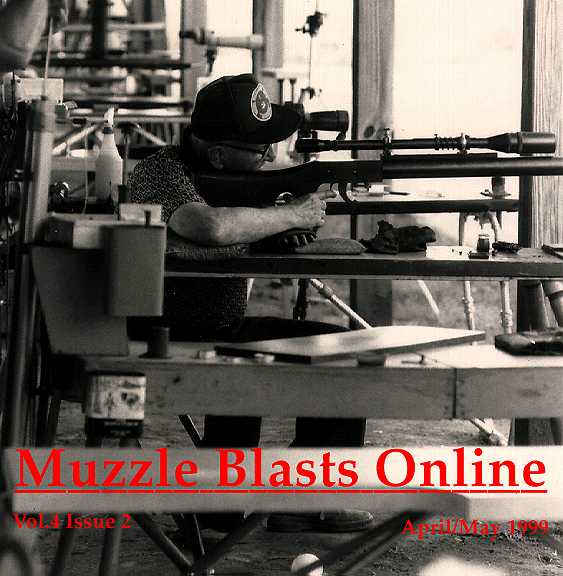|
Muzzle Blasts Online |
|
...for the muzzleloading enthusiast |
|
The muzzleblasts.com domain, subdomains, content, etc., are neither affiliated with the NMLRA nor its paper magazine Muzzle Blasts |
|
Muzzle Blasts Online |

|
|
|
|
|
|
Short Starts
A member's forum edited by Staff
Sweet William, the Searsburg, Vermont muzzleloading gunsmith who also answers to the name of Bill Douglas, fell from a height of nearly thirty feet some weeks ago while working on a construction project. By his description, he now knows that he goes splat, and does not bounce. He suffered broken bones and is recuperating at home. He asks customers who are waiting for guns to be patient, since his accident has set his schedule back a couple of months.
Reviewed in Brief: Golden Age Arms Co. recently sent us copies of two books it publishes. The first is entitled Black Powder: Let's Get Started! As the title indicates, this is an entry-level manual. It stresses safety and the fundamentals of loading, sighting in, and cleaning. The style is conversational, and the content should serve any beginner quite well. Any of us gray-beards who have been with the sport for decades might find something to disagree with here or there, but this book will keep neophytes out of trouble and put them into a position where they can pursue the hobby safely and enjoyably while they learn more.
James Johnston's book Building the Kentucky Rifle has been around for quite a while. This slender volume features fine, crystal-clear illustrations by Thomas F. White. First-time builders might come up with a few questions not covered in this book, but it is remarkably thorough in spite of its mere forty-two pages. If the novice builder follows the author's advice and begins with a pre-carved stock, studies a couple of good picture books, and examines some original rifles for esthetics, the result should be quite satisfactory.
Each of these books is just $7.50. I think they'd be appropriate gifts for people who need guidance in their respective subject areas. Contact Golden Age Arms, 115 E. High St., Box 366, Ashley, OH 43003.
Another delightful book that recently came to my attention is Fisher's River Scenes by Hardin Taliaferro. These entertaining stories of life in the Southern Highlands sprang from the author's experiences in the 1820's. They are filled with local color, regional dialect, humor, and customs of the region. There are also some "whoppers" or tall tales in the tradition of early American frontier humor. Taliaferro is a first-rate writer, and I found this book to be an enjoyable read. I got my copy from member Jim Webb (Rt. 1 Box 624, Hillsville, VA 24343). When you're in touch with Jim, also request information about his book Sketches of Hunting Pouches, Powder Horns, and Accoutrements of Southern Appalachia. We'll present a review of that fine work in an upcoming issue of Muzzle Blasts.
Remember the recent discussions in this column about insect damage to powder horns? Dr. James Pontillo, who creates exquisite quill work and is an institution at many NMLRA primitive rendezvous, writes with information about the menace to our treasures. The culprit is "a small, flying beetle similar to a lady bug but very small. It lays eggs, and the little larvae also eat quills, horns, and feathers… The larvae do not like light. The bug is small enough to fit through a screen…Most of the damage to quill work in museums that I've seen is the result of this insect." Dr. Pontillo has this advice to help us avoid damage to quillwork and horns: Store such items in a box that gets sprayed periodically with bug spray. Line the box with paper; consider keeping stored items in a sealable plastic bag. If you wish to display your quillwork or powder horns, keep them under glass.
Elmer Templeton (Benefactor Life Member #8) also wrote to share his experiences as a long-time collector of antique horns: Pesky insects seem to avoid horns containing powder; and a good protective measure is to keep horns in a closed case with moth crystals.
Guy Brown of Liverpool, NY wrote in with what may be the definitive information: "A call to an acquaintance at the New York State College of Environmental Science and Forestry Biology Lab revealed the following: Damage to horns is likely caused by the larva of the Dermestid Beetle as it feeds on the horn material. Prevention advice is to occasionally spray the horn with a household insect spray containing the active ingredient Pyrethrin. Regular insect spray, same as what we can buy at the local hardware, is what is used at the college to prevent insect damage to their collection of mounted birds and animals." Avoid the "outdoor use only" insect sprays.
Thanks to everyone who wrote in on this important topic! Now I have a parting question: Does anyone have any observations on the long-term effects of moth crystals and insect sprays on the dyes used on antique horns, or on the engraving on horns? Stay tuned!
NMLRA member Bill Tidwell of California has been recognized by Harrington and Richardson and Hunting Education Instructor magazine for his contributions to getting new hunters started right. Muzzle Blasts gladly joins them in extending congratulations to Bill for an important job well done.
Not long ago you read in this column that Muzzle Blasts seeks to start a new column designed to spread around the wealth of knowledge our members possess. It might be called "Tricks and Tips" (or something better that readers suggest!). Its intent is to share insights, shop tricks, shooting secrets, and tips of all kinds related to black powder shooting, gun building, rendezvous, and the like. Short items should be sent to the attention of the editor. The gems we select for publication will be rewarded with a $15 check. Illustrations and clear photos are welcome. Now it's up to you!